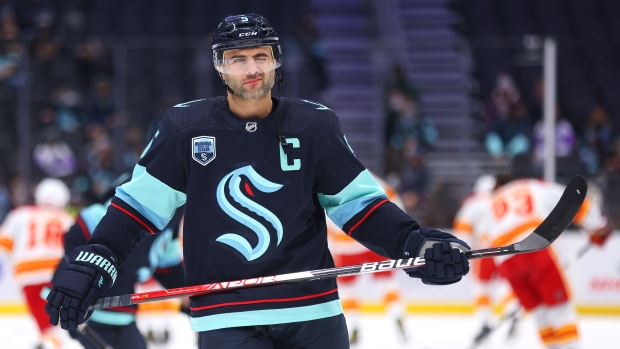Feb 18, 2022
Flames’ gamble on Giordano is paying off
Losing the veteran blueliner via the expansion draft couldn’t have been easy, but Calgary’s roster has met the challenge in an extraordinary way, Travis Yost writes.
By Travis Yost

The Calgary Flames losing captain Mark Giordano to the Seattle Kraken was one of the biggest surprises of the National Hockey League’s expansion draft in July.
It was a sensible pick for the Kraken – an aging but ultra-effective defender who could provide a significant veteran presence for the expansion team.
The decision to expose Giordano could not have been an easy one for Calgary. At the time of the draft, the team was very much in win-now mode, so punting arguably the most capable defender on your roster runs counter to that strategy.
Over the preceding five-year sample, Calgary was +68 goals with Giordano on the ice, and -47 goals when he wasn’t playing, comfortably one of the biggest differentials you could find across the league.
Calgary opting to expose Giordano meant protecting Chris Tanev alongside Noah Hanifin and Rasmus Andersson. It’s fair to say there wasn’t an easy choice for Calgary here, but it’s also reasonable to acknowledge the team gambled that it would be able to manage without Giordano. Whether that was a bet on its own players, on Giordano’s aging curve, or a combination of factors is up for debate.
What’s less up for debate is the impact that decision has had. Calgary is exploding up the Western Conference pecking order, even surpassing an injured-but-capable Vegas Golden Knights team for first place in the Pacific Division. The primary reason for the team’s 28-13-6 record is a third-ranked even-strength unit that continues to dictate pace and play under head coach Darryl Sutter.
One of the key reasons why Calgary is so dominant at even strength is each five-man unit can play in both directions; that requires a minimum of two higher-calibre defensive pairings, and ideally all three are capable of playing in that manner.
That’s precisely what Calgary is showing this season:

The pairing of Erik Gudbranson and Nikita Zadorov stands out because it is a bit more specialized – this isn’t a group of high-end puck movers, but rather the type of low-cost pairing you deploy in tough defensive minutes and hope you don’t get killed. To Gudbranson and Zadorov’s credit, the Flames have been an average even-strength team with them on the ice, trading goals with their opponents.
It's usually a good sign when your third pairing is trading goals, particularly if the defenders you are paying to drive performance are doing just that. Calgary’s top two pairings have crushed all season, in stark contrast to Giordano’s play for the Kraken this season.
I won’t be beating up Giordano for the diving goal differentials this season. The Kraken goaltending has been beyond dysfunctional, and every mistake (and then some) on the ice has led to a goal against.
But that’s why the expected goal trends are intriguing. Giordano looks much better there, as one would expect, but still pales in comparison to the Calgary’s top four. You could argue that the talent around Giordano has diminished relative to what he had around him in Calgary, but it fails to acknowledge that Giordano was fifth amongst defencemen in expected goals on the Calgary roster last season. Said another way: there were signs that his performance, likely due to aging and mileage, was starting to slip.
Twenty-eight pairings have played at least 500 minutes together this season, including all three Calgary groups. Calgary’s pairings rank first, second and fourth in expected goals. But more importantly, that puck dominance – a combination of controlled offensive-zone pressure and strong interior defensive play off the puck – has driven those big scoring chance differentials into goal dominance.
In the case of Tanev and Oliver Kylington, significantly so. Only the Radko Gudas and Gustav Forsling pairing in Florida (playing predominantly with the Jonathan Huberdeau line) has seen better numbers year-to-date:

It’s impossible to be a great defensive pairing without having some combination of credible attacking options or gifted defensive forwards in front of you, and that’s in some ways a testament to what the Flames forwards have accomplished. But a great unit requires competency on all sides of the table; there is a reason the Darnell Nurse and Evan Bouchard pairing has been outscored this year despite having regular access to Connor McDavid and Leon Draisaitl.
Sutter has been able to create multiple five-man units that are comfortably playoff-calibre. That was absolutely an open question in the wake of Giordano’s departure. But the Flames, and the team’s blueline in particular, have met the challenge in an extraordinary way.
Data via Natural Stat Trick, Evolving Hockey, NHL.com, HockeyViz

